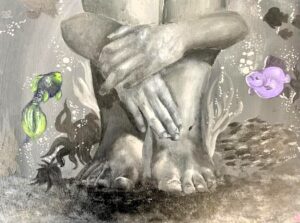Fr Pat Colgan visited St Louis’ Ballymena to present Conn Fyfe with his prize for second place in this year’s Columban Schools Media competition.
Fr Pat heard Conn’s Head Teacher Ms O’Neill and his RE teacher Ms Shauna Pickering praise his example as Head Boy, and highlight the numerous and heavy responsibilities, such as speech-giving, organizing events, school discipline issues that Conn undertook.
They also expressed their happiness with the school’s close connection with the Columbans through the competition and reminded Fr Pat that Fr Brendan Kelly, who is on mission in the Philippines, was a school alumnus.

Conn Fyfe on the Gaelic pitch.
Eighteeen-year-old Conn is a final year student at St Louis’ Grammar School, Ballymena. He is also a member of the Con McGee’s Glenravel GAC Football Minors, and a championship Irish Dancer who has performed at numerous Ulster Festivals and professionally at Belfast’s City Hall and Waterfront Convention Centre.
Fr Pat discovered that Conn is a second cousin of Columban Fr Kevin McHugh of Cushendun, Co Antrim. By coincidence, Fr Kevin recently met one of last year’s competition winners, Katie Bonnes from Ballymena at a mission appeal mass he said in Randalstown.

Fr Kevin McHugh
Conn’s subjects for A-Level are Irish, English Literature, Maths and Chemistry. His love for Irish came from his gaeilgoir mum, as well as his summers at the Gaeltacht of Magheroarty, Co Donegal.
He plans to study Actuary (according to Ms Pickering, the “niche” end of Financial Risk Management studies) at University College Dublin.
When asked why he decided to enter the Columban competition, Conn said it was because he realised that Biodiversity was not something that he felt he knew enough about, and that winning “has encouraged me to more explore on this, and climate change in general, through the lens of faith and as a young person”.
We wish Conn, and all our prize winners and entrants, every success in their ongoing studies, and are glad that the Far East has been part of their secondary school formation.

Conn on the dance floor
Here is Conn’s article which came second in this year’s ‘Biodiversity Matters’ competition:
What a Wildly Wonderful World, God!
The term ‘biodiversity’ was first coined by W.G. Rosen in 1985, but its conceptual origins hark back to God’s creation in Genesis. The interdependent, coexisting and flourishing world designed by God in his own image simultaneously incepted and consecrated all life on Earth; a glowing testament to the inherent value of all forms of life, and thereby the respect with which all life must be treated. In his mission, St. Columban preached, “if you want to know the Creator, look at creation.”
The divine satisfaction granted by this interconnected web of life encompassing all natural things continues to be enriched by each individual member of creation. This colourful biodiversity of life on our planet, however, is under threat. A bedrock in sustaining all forms of life, biodiversity on Earth should be an unimpeachable constant, yet it now functions as a source of exploitation and destruction.
“Each year sees the disappearance of thousands of plant and animal species which we will never know, which our children will never see, because they have been lost forever… We have no such right.” In his encyclical, Laudato Si, Pope Francis articulates the scathing effects of human activity in contributing to this ecological crisis.
Mass globalisation has reduced the Earth to a mere resource, a seemingly perpetual source of profit, something to be used, not revered. God saw value in all his creatures, yet this value was not quantified in terms of useful potential for human beings, their very existence was valuable. In our contemporary society, however, God’s sacred creation is viewed through the myopic eyes of gluttony, not gratitude; through an insatiable lust for consumption, not conservation.
Humanity has become complicit in the destruction of the very ecosystems that sustain our own life on this planet, and large-scale human behaviour has incited a plethora of irreversible natural atrocities encompassing deforestation and coral bleaching. Our need for systemic change is clear, mirrored in Pope Francis’s words, ‘Many things have to change course, but it is we human beings above all who need to change.’
The co-dependency between nature and humanity is innately divine in nature, as we mirror God’s own inception of a unified and coexisting world. This unity is belied, however, by the war that humanity continues to ravage with the natural world; the natural world that we so readily depend on, yet so readily neglect. Humans and nature are indiscernible; we are part of this biodiverse world.
Our welfare is innately linked to that of our fellow creatures, yet our destructive tendencies fuelled by a gross desire for productivity renders us blind to this fact. According to the World Wildlife Fund, the world has seen a 68% drop in mammal, bird, fish, reptile, and amphibian populations since 1970.

Keelin Bellemand of Le Cheile Tyrrelstown’s image which came second in the image category.
This rapid rate of ecological decline is an indictment of an anthropocentric outlook that has culminated in a proliferation of widespread extinction and ultimately spiritual transgression. The sanctity of the seven days of creation has been disdained and diluted by humanity; we now inhabit an almost parallel, antithetical eighth day of destruction, a dichotomy, destroying what God endeavoured to create.
Transcending a lack of action towards the preservation of our ecological world, an indifference to biodiversity is in itself a rebellion against the sanctity of God’s creation; ‘We know that the whole creation has been groaning as in the pains of childbirth’ (Romans 8:22) As a result of human negligence, God’s sacred creation is in pain, with our own destructive actions at the epicentre of this suffering.
The Earth is inherently mother-like in nature, guarding and protecting us against harm, yet we continue to forsake its sanctified biodiversity, this gift from God, to fuel our own selfish interests. Not only are we instigating an ecological and climate crisis through these actions, but we similarly generate a spiritual crisis, a sin against our Creator and his wonderful creation.
Through this image of childbirth, however, Pauline theology also espouses a message of hope. A moment of ‘birth’ in which pain is dispelled, propagating that a moment of metanoia is not only possible, but imminent. Perhaps this ‘eighth day’ we now inhabit can be reimagined. In this vein, we look to the celebration of the Season of Creation, an exultation in the wonders of our world bestowed to us by God. In particular, the theme for 2024, “To hope and act with Creation” epitomises the need for both reform and progression.
Hope, in an ecological context, ultimately stems from human action and is rooted in our own desire for change. Biodiversity is fundamental to the functioning of our world; our oceans, our skies, and indeed our health and well-being, each strand is underpinned by the variety of life on Earth. By truly hoping and acting with creation, we restore the sanctity of our world and our home, through the consecrated medium of biodiversity.
Humanity, therefore, has a dual role within God’s creation. We are called to glorify God and similarly protect and preserve our fellow creatures. An abolition of biodiversity is an abolition of God’s character and his purpose for us, and humanity must therefore strive to replenish what we have already lost, and safeguard what remains. God exults in the existence of all forms of life on Earth and biodiversity is accordingly paramount in not only impeding a climate and ecological crisis, but in maintaining God’s varied and vibrant creation in which we, his children, can prosper. Psalms 104:24 proclaims this; “What a wildly wonderful world, God!”. Indeed, it is this wonderful world which we must work to protect.

